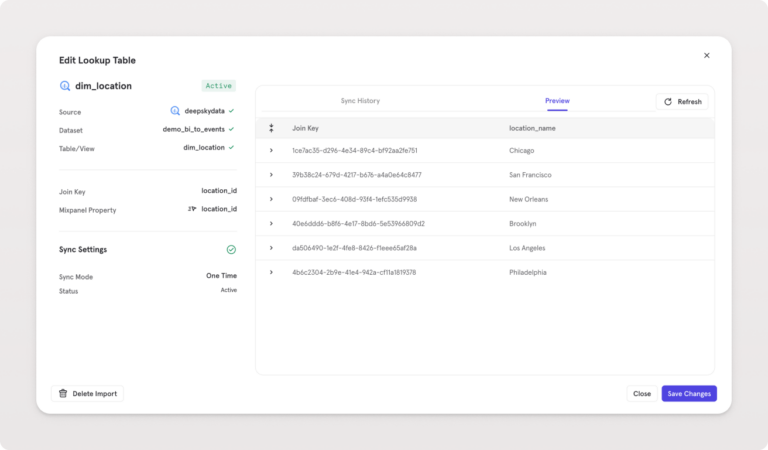What is a unified data model?
A unified data model brings together data from different sources and platforms in one place. This unification means all your data is considered when conducting analyses and making decisions.
Imagine trying to assemble a jigsaw puzzle where every piece comes from a different set. Nothing fits, and the picture never comes together.
That’s what working at organizations with siloed, inconsistent data sources feels like. There might be a bigger picture in there somewhere, but you’re not going to see it with the pieces you have.
Unified data models solve that problem. They bring data together to form a clear picture that organizations use to drive smarter decisions and get better results. Let’s dive into what a unified data model is and why it’s important.
What is a unified data model?
Most companies have multiple data sources, platforms, and ecosystems that operate in silos. Maybe they connect to an internal tool or an analytics platform that only a handful of teams use for a very specific use case.
In such scenarios, certain data points are likely overlooked when important decisions are made, simply because those data points weren’t included in the initial dataset.
Making decisions with incomplete data is barely better than making decisions without any data at all—especially when the stakes are high and millions of dollars are on the line.
A unified data model bridges together various disparate data sources—like CRMs, BI tools, product analytics platforms, ERPs, and others—and consolidates or represents them in a single data set or data warehouse. This provides you with unified data, enabling you to run analyses and make decisions based on all of the information available.
Unified data is important because it allows you to understand the entire data narrative. Without it, you’re left with multiple silos of (often incomplete) data which can blur the bigger picture—and thus prevent data from being accurate, effective, and actionable.
What is unified data management?
Unified data management (UDM) is a framework that helps unify data by implementing processes, platforms, and tools to consolidate data from disparate locations. Usually, UDM involves integrating different data sources and storing the unified data in a common data warehouse, then adding a layer of analytics tools that allow you to query that data.
Directing data from various silos to a single system is easier said than done, however, since platforms used to gather data are often incompatible. Each platform has its own data model and operating system, which means it may not speak to other platforms or have a compatible interface.
Making the most of all your data with unified data management requires a well-implemented unified data model.
Why product teams need a unified data model
Unified data is important across teams, especially when it comes to collaboration.
If your revenue, CRM, and ad-spend data aren’t unified into a single source of truth, for example, how can you answer granular questions, like which acquisition channels have the highest ROAS? Or whether adding a new feature had an impact on support tickets? Having all of your data in a single place allows teams to work together to understand the impact their actions have across the company.
Implementing a unified data model is especially useful for product teams. With a unified data model, product teams can understand:
- How their product decisions play out for the rest of the company (like the example above with support tickets)
- How things that happen outside the product impact the user experience
Using unified data eliminates miscommunication and ensures that everyone is working with accurate, reliable, and accessible data. When done well, building a unified data model also creates scalable data infrastructure, which allows teams to integrate new tools and platforms as they grow without disrupting existing workflows.
Unified data models in practice: Unifying a fragmented data ecosystem
Food delivery company Deliveroo needed to bring its disjointed analytics ecosystem into one unified data model. Partners could interact with multiple applications, including a marketing site, a blog, a restaurant portal, and a tablet app—all of which published metrics and events in vastly different ways.
With Mixpanel, Deliveroo was able to gather information under a single umbrella. That change gave them deeper insights into the totality of their user behavior, which ultimately helped them make data-driven decisions about which features to prioritize.
Components of a unified data model
Creating a unified data model requires a few key elements:
Data integration
To ensure compatibility as your data collection and tech stack grows, a comprehensive unified data model should be flexible enough to integrate with new platforms and data sources. Ideally, your unified data model should be able to integrate data from each platform with limited manual intervention and preferably be able to sync changes in the unified data with important tools like product analytics.

A unified data model connects diverse tools and platforms, including CRMs, product analytics tools like Mixpanel, data warehouses, and marketing tools. These platforms sometimes have different data models, which can require some translation or consolidation.
Single source of truth
A unified data model gives your entire company a single source of truth for all of your data, (usually your data warehouse). This ensures that all teams are referencing the same data sources and making decisions based on the same information.
Data governance and security
With all of your data stored in one place and analyzable, it’s important to ensure you have proper data governance and security measures in place to maintain control over sensitive data.
Benefits of unified data models for product teams
Unified data models offer lots of benefits for product teams. Most importantly, they provide clean, consistent data for product analytics platforms like Mixpanel, which gives product teams access to better insights about how users are interacting with products.
Those insights are the key to faster decision-making, too. When product managers can trust the data they’re analyzing without second-guessing inconsistencies, they’re more likely to move quickly, test theories, and make product changes based on real data.
Most importantly, using a unified data model helps designers, engineers, and product managers collaborate with shared data insights to improve user experience. Unified data means a better product and happier users.
Unified data models in practice: Increasing user engagement and retention
With multiple teams working across the same products, leading Mexican brokerage firm GBM needed to go beyond basic insights to track the hidden dynamics of user behavior with clear metrics available to everyone.
GBM adopted Mixpanel as a single source of truth for data, eliminating discrepancies and promoting decision-making based on accurate information. Having a consistent set of metrics through Mixpanel helps to create a unified sense of understanding, allowing all departments to be aligned. Mixpanel’s dashboards and insights are easily understandable for every team, ensuring a cohesive interpretation of data across the organization.
Challenges in implementing a unified data model
Hopefully, we’ve convinced you of the benefits of a unified data model by now. But there are a few pitfalls to look out for when implementing unified data models:
Data silos
A unified data model aims to reconcile and integrate data from disparate sources. But with different tools using different systems and speaking different languages, this can be easier said than done. Using platforms with convenient, powerful integrations (like Mixpanel) is key to breaking down these silos and building the path to unified data management.
Change management
Adopting unified data practices often requires an organizational shift, especially when teams are used to each playing in their own sandbox, with their own tools, data, and processes. Demonstrating the value of self-serve analytics and unified data models for data-informed teams can help overcome reluctance. We also recommend offering training so that employees see firsthand how the data tools you implement will help them be more successful in their own roles.
Scalability
Data collection, storage, and management are continuous processes. As the amount of data increases over time, your unified data model needs to be able to scale up to handle the increased volume, as well as any potential increase in the types of data it has to manage.
Best practices for using a unified data model with Mixpanel
Data, unified or not, is no good if the people who need it don’t have access to it. A unified data model should be accessible across your business so that teams can use it to make the right decisions. Democratizing data eliminates bottlenecks in analysis and ensures that data insights are shareable across the organization. Mixpanel makes this possible by allowing anyone at your organization to self-serve analysis and insights.
Here are a few tips for using a unified data model with Mixpanel:
- Maintain clean data pipelines. Use Mixpanel’s integrations to ensure consistent data flow.
- Leverage Mixpanel’s Boards and Reports to enable cross-team collaboration and keep everyone aligned.
- Monitor and refine the model: Regularly review the unified data model’s effectiveness in driving product decisions.
Making the most of your data
Data can be empowering, but when it’s fragmented, valuable insights will be overlooked. Understanding your users is only possible if multiple data sources are pieced together to give you data and insights across the entire user lifecycle.
This can only happen when data ingested from multiple platforms, such as product analytics, is unified with other platforms to give you a more complete picture of your users and their product usage.
A unified data model will not only make data storage more manageable and comprehensive but also help to future-proof data reporting and analysis as your business grows.


